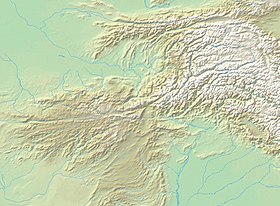Trakhan dynasty
Kayānis dynasty (Trakhan dynasty) | |||||||||
|---|---|---|---|---|---|---|---|---|---|
| 780 CE–1821 CE | |||||||||
 Udabhandapura TRAKHAN DYNASTY | |||||||||
| Status | Dynasty | ||||||||
| Capital | Gilgit | ||||||||
| Religion | Islam | ||||||||
| Government | Monarchy | ||||||||
| Shahi | |||||||||
| Historical era | Middle Ages | ||||||||
• Established | 780 CE | ||||||||
• Disestablished | 1821 CE | ||||||||
| |||||||||
| Today part of | Pakistan India | ||||||||
The Trakhan dynasty, initially known as the Kayānis dynasty until 1241 CE,[1] was a dynasty of rulers in Gilgit and Hunza, established in the 8th-9th century CE after the overthrow of the Patola Shahis.[2] The Trakhan dynasty is considered to be of Turkic origin, and to have been established some time in the 8th century, following the departure of the Chinese from region circa 760 CE at the time of the An Lushan Rebellion.[3][1] Various Arab texts and inscriptions record the rule of Turkic rulers in the region of Gilgit at that time, as well as conflicts with Arab forces circa 810-830 CE.[1] The dynasty lasted until 1810.[4]
According to tradition, the founder of the dynasty was an imaginary character named (also known as Shamsher), a Kayani prince from Persia, who had fled the Arab invasion. He secretly married the daughter of Shri Badat, the last Buddhist ruler of Gilgit.[5][4] She conspired with him to overthrow her cannibal father. Sri Badat's faith is theorised as Hindu by some[6][7] and Buddhist by others.[8][9] However, considering the region's Buddhist heritage, with the most recent influence being Islam, the most likely preceding influence of the region is Buddhism.
Prince Azur Jamshid succeeded in overthrowing King Badat who was known as the Adam Khor (literally "man-eater"),[10][11] often demanding a child a day from his subjects, his demise is still celebrated to this very day by locals in traditional annual celebrations.[12] In the beginning of the new year, where a Juniper procession walks along the river, in memory of chasing the cannibal king Sri Badat away.[13] Azur Jamshid abdicated after 16 years of rule in favour of his wife Nur Bakht Khatùn until their son and heir Garg, grew of age and assumed the title of Raja and ruled, for 55 years.
The dynasty flourished under the name of the Kayani dynasty until 1421 when Raja Torra Khan assumed rulership.[1] From this time, the dynasty was named "Trakhan" after him.[1] He ruled as a memorable king until 1475. He distinguished his family line from his stepbrother Shah Rais Khan (who fled to the king of Badakshan, and with whose help he gained Chitral from Raja Torra Khan), as the now-known dynastic name of Trakhàn. The descendants of Shah Rais Khan were known as the Ra'issiya Dynasty.[14]
Gilgit was ruled for centuries by the local Trakhàn Dynasty, which ended about 1810 with the death of Raja Abas, the last Trakhàn Raja.[15] The rulers of Hunza and Nager also claim origin with the Trakhàn dynasty.
References[]
- ^ a b c d e History of Civilizations of Central Asia. UNESCO. January 1998. p. 216. ISBN 978-92-3-103467-1.
- ^ "Here within the niche is a late Brahmi inscription of 8th - 9th century A.D. The inscription for the first time gives the tribal name Trakha , probably referring to the Trakhan dynasty who ruled over Gilgit and Hunza after the overthrow of the Patola Shahis and started the mediaeved history of the region ." in Dani, Ahmad Hasan (1995). Human Records on Karakorum Highway. Sang-e-Meel Publications. p. 7. ISBN 978-969-35-0646-4.
- ^ "Next came the migration of Turkish tribes in our country in the 7th and 8th centuries A.D. In the Northern Areas of Pakistan the Trakhan dynasty of Gilgit came from across Pamir and established the Turkish rule in Gilgit, Hunza and Nagir" in Dani, Ahmad Hasan (1993). New Light on Central Asia. Sang-e-Meel Publications. p. 37. ISBN 978-969-35-0294-7.
- ^ a b History of Civilizations of Central Asia. UNESCO. January 1998. pp. 216–217. ISBN 978-92-3-103467-1.
- ^ Bradnock, Robert W. (1994). South Asian Handbook. Trade & Travel Publications. p. 1168.
- ^ Amar Singh Chohan (1984) The Gilgit Agency, 1877–1935, Atlantic Publishers & Distributors, p. 4
- ^ Reginald Charles (1976) Between the Oxus and the Indus, Francis Schomberg, p. 249
- ^ Henry Osmaston, Philip Denwood (1995) Recent Research on Ladakh 4 & 5: Proceedings of the Fourth and Fifth, Motilal Banarsidass, p. 226
- ^ Ahmad Hasan Dani (1989) History of Northern Areas of Pakistan, Islamabad : National Institute of Historical and Cultural Research, p. 163
- ^ Imperial Gazetteer of India. Provincial Series: Kashmir and Jammu, ISBN 0-543-91776-2, Adamant, p. 107
- ^ Reginald Charles (1976) Between the Oxus and the Indus, Francis Schomberg, p. 144
- ^ [1][dead link]
- ^ Henry Osmaston, Philip Denwood (1995) Recent Research on Ladakh 4 & 5, Motilal Banarsidass Publ., p. 229
- ^ Ahmad Hasan Dani (1999) History of Civilizations of Central Asia, Motilal Banarsidass Publ, pp. 216–217
- ^ Frederick Drew (1875) The Jummoo and Kashmir Territories: A Geographical Account E. Stanford, London, OCLC 1581591
- Asian royal families
- People from Gilgit
